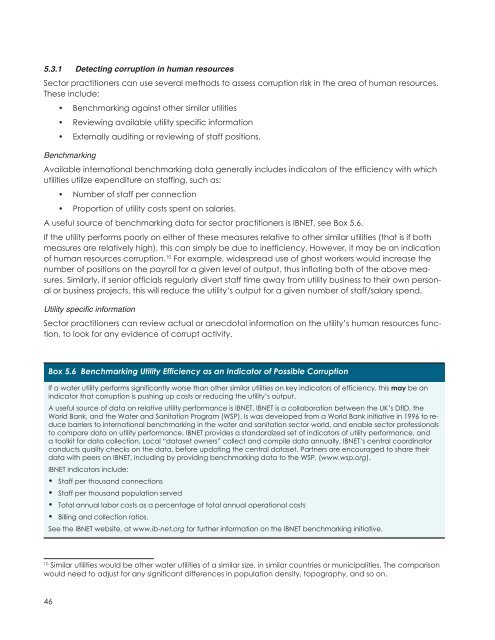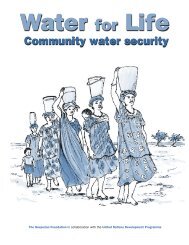A Sourcebook - UN-Water
A Sourcebook - UN-Water
A Sourcebook - UN-Water
Create successful ePaper yourself
Turn your PDF publications into a flip-book with our unique Google optimized e-Paper software.
5.3.1 Detecting corruption in human resources<br />
Sector practitioners can use several methods to assess corruption risk in the area of human resources.<br />
These include:<br />
• Benchmarking against other similar utilities<br />
• Reviewing available utility specific information<br />
• Externally auditing or reviewing of staff positions.<br />
Benchmarking<br />
Available international benchmarking data generally includes indicators of the efficiency with which<br />
utilities utilize expenditure on staffing, such as:<br />
• Number of staff per connection<br />
• Proportion of utility costs spent on salaries.<br />
A useful source of benchmarking data for sector practitioners is IBNET, see Box 5.6.<br />
If the utility performs poorly on either of these measures relative to other similar utilities (that is if both<br />
measures are relatively high), this can simply be due to inefficiency. However, it may be an indication<br />
of human resources corruption. 10 For example, widespread use of ghost workers would increase the<br />
number of positions on the payroll for a given level of output, thus inflating both of the above measures.<br />
Similarly, if senior officials regularly divert staff time away from utility business to their own personal<br />
or business projects, this will reduce the utility’s output for a given number of staff/salary spend.<br />
Utility specific information<br />
Sector practitioners can review actual or anecdotal information on the utility’s human resources function,<br />
to look for any evidence of corrupt activity.<br />
Box 5.6 Benchmarking Utility Efficiency as an Indicator of Possible Corruption<br />
If a water utility performs significantly worse than other similar utilities on key indicators of efficiency, this may be an<br />
indicator that corruption is pushing up costs or reducing the utility’s output.<br />
A useful source of data on relative utility performance is IBNET. IBNET is a collaboration between the UK’s DfID, the<br />
World Bank, and the <strong>Water</strong> and Sanitation Program (WSP). Is was developed from a World Bank initiative in 1996 to reduce<br />
barriers to international benchmarking in the water and sanitation sector world, and enable sector professionals<br />
to compare data on utility performance. IBNET provides a standardized set of indicators of utility performance, and<br />
a toolkit for data collection. Local “dataset owners” collect and compile data annually. IBNET’s central coordinator<br />
conducts quality checks on the data, before updating the central dataset. Partners are encouraged to share their<br />
data with peers on IBNET, including by providing benchmarking data to the WSP, (www.wsp.org).<br />
IBNET indicators include:<br />
• Staff per thousand connections<br />
• Staff per thousand population served<br />
• Total annual labor costs as a percentage of total annual operational costs<br />
• Billing and collection ratios.<br />
See the IBNET website, at www.ib-net.org for further information on the IBNET benchmarking initiative.<br />
10<br />
Similar utilities would be other water utilities of a similar size, in similar countries or municipalities. The comparison<br />
would need to adjust for any significant differences in population density, topography, and so on.<br />
46
















